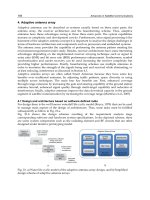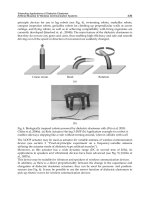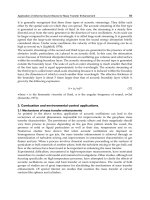Advanced Trends in Wireless Communications Part 16 docx
Bạn đang xem bản rút gọn của tài liệu. Xem và tải ngay bản đầy đủ của tài liệu tại đây (226.01 KB, 7 trang )
Trends and Challenges in CMOS Design for Emerging 60 GHz WPAN Applications
515
mW. Table 3 shows the performance of this mixer compared to the previous published 60
GHz mixers. This dual-gate mixer shows a good compromise between simplicity and good
performances.
(Emami et al.,
2005)
(Lai et al.,
2006)
(Wang & Tsai,
2009)
(El Oualkadi
et al, 2009)
(Lien et al.,
2010)
Approach Single-gate Cascode Bulk-driven Dual-gate
Double-
balanced
Process 130nm CMOS 90nm CMOS 130nm CMOS 65nm CMOS 130nm CMOS
Freq (GHz) 54-61 60 51-61 60
Conversion
Gain (dB)
-1 @ 60 GHz -1.2 1 @ 60 GHz 0.4
-3
∼0
Input P
1dB
(dBm)
-3.5 0.2 -19 1.264 -8
Suppl
y
Volta
g
e
(V)
1.2 - 1 1.2 -
Power
consumption
(mW)
2.4 29.4 3 8.5 14
Table 3. Performance comparisons of some millimeter wave mixers reported in the state-of-
the-art
6.3 Oscillators
A key building block in radio transceiver is the VCO which is employed as a LO for
assuring the modulation/demodulation. The implementation of VCOs in CMOS technology
is justly felt as one of the major challenges that must be overcome in the design of integrated
60 GHz WPAN transceivers (Regimbal et al., 2009). Indeed, the limited transistor speeds and
long interconnects causes some critical issues related to the generation of I and Q phases of
the LO at 60 GHz. The quadrature operation typically degrades the phase noise
considerably (Razavi, 2005). While, the division of LO frequency poses a problem, since; the
design of high-speed dividers requires many challenges at 60 GHz (Razavi, 2009). Besides
these challenges, a number of performance requirements have to be met to make a VCO
suitable for 60 GHz WPAN applications . Most importantly, low phase noise is required to
avoid corrupting the mixer-converted signal by close interfering tones. Low power
consumption and tenability are also two important aspects that define the performance of a
VCO (Razavi, 2000).
The ring oscillators and passive RC-CR networks are two of the most commonly used
solutions for quadrature generation. While ring oscillators are widely used for digital-based
applications, passive networks suffer from high loss and inaccuracy. The LC cross-coupled
oscillators and Colpitts oscillators are the most suitable for RF and millimeter applications
due to their excellent phase noise performance (Kim et al., 2008). However, the use of
several inductors in the LC VCOs leads to difficulties in the layout. Indeed, the substrate
loss affects directly the quality factors of inductors and varactors in the millimeter wave
range (Liang et al., 2009). Therefore, the trade-offs between the phase noise, the tuning
range, and the power dissipation become much more severe (Razavi, 2009).
Advanced Trends in Wireless Communications
516
The millimeter wave CMOS oscillators proposed in the literature commonly used a cross
coupled transistor pair with different resonator structures (Farahabadi et al., 2009).
An example of a LC VCO based on cross coupled topology is proposed in (Borremans et al.,
2008). This design implemented in 130 nm CMOS shows interesting performances at 60
GHz. The measured phase noise is below -90 dBc/Hz at 1 MHz offset with a power
consumption of 3.9 mW at 1 V. The tuning range exceeds 10 %, for a tuning voltage
restricted from ground to the supply (Borremans et al., 2008). Such performances can allow
this VCO to be an interesting solution for WPAN applications.
To realize the direct dowconversion operation, a 60 GHz receiver requires a VCO with
quadrature phase generation. A VCO using an injection-coupled topology is used in (Sakian
et al. 2009) to generate quadrature 60 GHz outputs. Fig. 10 shows the schematic of this VCO.
Fig. 10. The two LC-VCOs coupled in anti-phase to provide I-Q outputs (Sakian et al. 2009)
The required negative conductance is generated by the cross-coupled pairs M1-M2 and M3-
M4. The coupling transistors M5-M8 inject the output signals of one cross-coupled pair to
the input of the other to produce anti-phase coupling required for quadrature generation
(Sakian et al. 2009).
The measurements show a tuning range of 5.6 GHz (57.5 to 63.1 GHz), a phase noise of
-95.3 dBc/Hz at 1 MHz offset and a power consumption of 36 mW. Despite the additional
challenges and limitations imposed by the quadrature topology, the obtained performances
are comparable to state of the art single-phase VCOs, (Sakian et al. 2009).
7. Conclusion
During the recent years, the 60 GHz band has gained increased academic and commercial
interest mainly due to the availability of a large unlicensed spectrum in the vicinity of 60
GHz. Nowadays, thanks to the development of the IEEE 802.15.3c standard for WPAN,
various commercial applications have been emerged. Thus, the 60 GHz band is considered
as an attracting solution for broadband wireless in particularly for short range and high data
rate applications.
The implementation of new 60 GHz wireless applications is strictly related to the
development of high performance 60 GHz radio transceivers. This implies that the designers
of circuits and systems must overcome several challenges and trade-offs which occurring
when working in the millimeter wave spectrum (Hajimiri, 2007).
The CMOS technology which is the dominating technology for most wireless products
below 10 GHz, is characterized by reliability, maturity, low manufacturing cost and low
Trends and Challenges in CMOS Design for Emerging 60 GHz WPAN Applications
517
power consumption compared to traditional semiconductor technologies based on III-V
compound materials such as SiGe and GaAs. In addition, CMOS is the most suitable
technology for designing system-on-chip, since it enables integration of the analog RF
circuits with the digital signal processing and baseband circuits in the lowest possible chip
area, which leads to a lower cost and more compact solution. With the enormous world-
wide effort to scale to lower gate-lengths, CMOS technology is pushing further into the
millimeter wave region with maximum frequency of oscillation exciding 300 GHz
promising increasing performance in the future (Niknejad, 2008).
Today, the interest on designing millimeter wave CMOS circuits and systems is growing
rapidly offering a fertile ground for innovation. CMOS technology is becoming the strong
candidate for implementing low cost and less power consuming 60 GHz WPAN
transceivers which are expected to boost wireless communication data rates to the order of
multi-gigabit-per-second.
Actually, if several efforts have been done that ameliorate the challenges in millimeter wave
design many questions still remain (Razavi, 2009). Therefore, various areas of investigation
will certainly be the subject of deep research in the next coming years. For example:
-
At the device level, several efforts should be done in the accurately modeling of both
active and passive devices in the millimeter wave band. The objective is to have scalable
models which would allow an efficient design of the building blocks.
-
At the circuit level, some building blocks require new design techniques in order to
improve the targeted performance at 60 GHz, like power amplifiers and switches. The
integration of antennas still remains as a big challenge to promote the single on-chip
transceivers.
-
At the system level, new methodologies for simulation of large transceivers and their
layouts should be developed. Issues related to packaging must be solved to facilitate
coupling among various building blocks through the power lines and the substrate.
8. References
Baldwin, G. L. (2007). Background on development of 60 GHz for commercial use.
SiBEAM.com, white paper
Barakat, M. H. (2008). Dispositif Radiofréquence Millimétrique Pour Objets Communicants
de Type Smart Dust. PhD Thesis. University of Joseph Fourier, Grenoble, France.
Borremans, J.; Dehan, M.; Scheir, K.; Kuijk, M. and Wambacq, P. (2008). VCO design for 60
GHz applications using differential shielded inductors in 0.13um CMOS.
Proceedings of IEEE Radio Frequency integrated Circuits Symposium (RFIC 2008), pp.
135-138, ISBN 0-7803-8983-2, Atlanta, Georgia, USA, June 2005, IEEE, Piscataway
Daniels, R. C. & Heath, R. W. (2007). 60 GHz Wireless Communications: Emerging
Requirements and Design Recommendations. IEEE Vehicular Technology
Magazine, Vol. 2, N. 3, pp. 41-50, ISSN 1556-6072
Doan C. H.; Emami, S.; Niknejad, A.M. and Brodersen, R.W. (2004). Design of CMOS for 60
GHz applications,
Proceedings of IEEE International Solid-State Circuits Conference
(ISSCC ’04), pp. 440-538, ISBN 0-7803-8267-6, San Francisco, California, USA, Feb.
2004, IEEE, Piscataway
Doan, C. H.; Emami, S.; Niknejad, A. M & Brodersen R. W. (2005). Millimeter-wave CMOS
design.
IEEE J. Solid-State Circuits, Vol. 40, No. 1, pp. 144–155, ISSN 0018-9200
Advanced Trends in Wireless Communications
518
El Oualkadi, A. ; Faitah, K. & Ouahman, A. A. (2009). mm-Wave CMOS Mixer Design in 65
nm Technology for 60 GHz Wireless Communications,
Proceedings of IEEE
Mediterranean Microwave Symposium (MMS'09)
, pp. 1-4, ISBN 978-1-4244-4664-3,
Tangier, Morocco, Nov. 2009, IEEE, Piscataway
Emami, S.; Doan, C.H.; Niknejad, A.M. and Brodersen, R.W. (2005). A 60-GHz down-
converting CMOS single-gate mixer.
Proceedings of IEEE Radio Frequency integrated
Circuits Symposium (RFIC 2005),
pp. 163-166, ISBN 0-7803-8983-2, Long Beach,
California, USA, June 2005, IEEE, Piscataway
Emami, S.; Doan, C.H.; Niknejad, A.M. and Brodersen, R.W. (2007). A Highly Integrated
60GHz CMOS Front End Receiver.
Proceedings of IEEE Solid-Sate Circuits Conference
(ISSCC2007), Digest of technical papers
, pp. 190-191, ISBN 1-4244-0853-9, San
Francisco, California, USA, Feb. 2007, IEEE, Piscataway
Farahabadi, P. M.; Naimi, H. M. & Zabihi, M. (2009). An enhanced low phase noise VCO in
130 nm CMOS for 60 GHz applications,
Proceedings of 2nd International Conference on
Power Electronics and Intelligent Transportation System (PEITS), pp. 40-43, ISBN 978-1-
4244-4544-8, Shenzhen, China, Fev. 2009, IEEE, Piscataway
FCC. (1997). Millimeter Wave Propagation: Spectrum Management Implications.
Federal
Communications Commission – Office of Engineering and Technology, Bulletin N 70,
Washington, DC 20554.
Floyd, B.A.; Reynolds, S.K.; Pfeiffer, U.R.; Zwick, T.; Beukema, T. & Gaucher, B. (2005). SiGe
bipolar transceiver circuits operating at 60 GHz.
IEEE J. Solid-State Circuits, Vol. 40,
No. 1, pp. 156–167, ISSN 0018-9200
Friis, H. T. (1944). Noise figures of radio receivers.
Proceedings of the IRE, Vol. 32, No. 7, pp.
419–422, ISSN 0096-8390
Guo, N.; Qiu, R. C.; Mo, S. S. & Takahashi, K. (2007). 60-GHz Millimeter-Wave Radio:
Principle, Technology, and New Results.
EURASIP Journal on Wireless
Communications and Networking, Vol. 2007, Article ID 68253, pp. 1-8, ISSN 1687-1499
Hajimiri, A. (2007). mm-Wave Silicon ICs: Challenges and Opportunities.
Proceedings of IEEE
Custom Intergrated Circuits Conference (CICC 2007), pp. 741-748, ISBN 978-1-4244-
1623-3, San Jose, California, USA, Sep. 2007, IEEE, Piscataway
Kang, K.; Brinkhoff, J. and Lin, F. (2010). A 60 GHz LNA with 18.6 dB gain and 5.7 dB NF in
90nm CMOS.
Proceedings of IEEE International Conference on Microwave and
Millimeter Wave Technology (ICMMT 2010),
pp. 164-167, ISBN 978-1-4244-5705-2,
Chengdu, China, May 2010, IEEE, Piscataway
Kim, N.; Lee, S. and Rieh, J-S. (2008). A Millimeter-Wave LC Cross-Coupled VCO for 60
GHz WPAN Application in a 0.13-µm Si RF CMOS Technology.
IEEE Journal of
Semiconductor Technology and Science, Vol. 8, No. 4, pp. 295–301, ISSN 1598-1657
Lai, I.C.H.; Kambayashi, Y. and Fujishima, M. (2006). 60-GHz CMOS Down-Conversion
Mixer with Slow-Wave Matching Transmission Lines,
Proceedings of IEEE Asian
Solid-State Circuits Conference (ASSCC 2006), pp. 195-198, ISBN 0-7803-9734-7,
Hangzhou, China, Nov. 2006, IEEE, Piscataway
Lee, W.; Kim, J.; Cho, C. S & Yoon, Y. J. (2010). Beamforming Lens Antenna on a High
Resistivity Silicon Wafer for 60 GHz WPAN.
IEEE Transactions on Antennas and
Propagation, Vol. 58, No. 3, pp. 706–713, ISSN 0018-926X
Leenaerts, D.; Van der Tang, J.; Vaucher C. S. (2001).
Circuit Design for RF Transceivers, pp. 1-
344, Kluwer Academic Publishers, ISBN 978-0792375517, USA
Trends and Challenges in CMOS Design for Emerging 60 GHz WPAN Applications
519
Liang, C. and Razavi, B. (2009). Systematic transistor and inductor modeling for millimeter
wave design.
IEEE J. Solid-State Circuits, Vol. 44, No. 2, pp. 450-457, ISSN 0018-9200
Lien, C-H.; Huang, P-C. ; Kao, K-Y.; Lin, K-Y. and Wang, H. (2010). 60 GHz Double-
Balanced Gate-Pumped Down-Conversion Mixers With a Combined Hybrid on 130
nm CMOS Processes.
IEEE Microw. Wireless Compon. Lett., Vol. 20, No. 3, pp. 160-
162, ISSN 1531-1309
Majek, C.; Severino, R.R.; Taris, T.; Deval, Y.; Mariano, A.; Begueret, J B. and Belot, D.
(2009). 60 GHz cascode LNA with interstage matching: performance comparison
between 130nm BiCMOS and 65nm CMOS-SOI technologies.
Proceedings of 3rd
IEEE International Signals, Circuits and Systems (SCS 2009),
pp. 1-5, ISBN 978-1-4244-
4397-0, Medenine, Tunisia, Nov. 2009, IEEE, Piscataway
Maruhashi, K.; Tanomura, M.; Hamada, Y.; Ito, M.; Orihashi, N. and Kishimoto, S. (2008).
60-GHz-Band CMOS MMIC Technology for High-Speed Wireless Personal Area
Networks.
Proceedings of IEEE Compound Semiconductor Integrated Circuits
Symposium (CSIC '08), pp. 1-4, ISBN 978-1-4244-1939-5, Monterey, California, USA,
Oct. 2008, IEEE, Piscataway
Moore, G. E. (1965). Cramming more components onto integrated circuits.
IEEE Proceedings,
Vol. 38, No. 8, pp. 82–85, ISSN 0018-9219
Motlagh, B.M.; Gunnarsson, S.E.; Ferndahl, M. and Zirath, H. (2006). Fully integrated 60-
GHz single-ended resistive mixer in 90-nm CMOS technology.
IEEE Microw.
Wireless Compon. Lett.,
Vol. 16, No. 1, pp. 25–27, ISSN 1531-1309
Niknejad, A. M. & Hashemi, H. (2008).
mm-Wave Silicon Technology 60 GHz and Beyond, pp.
1-302, Springer, ISBN 978-0-387-76558-7, USA
Parsa, A. and Razavi, B. (2009). A new transceiver architecture for the 60-GHz band.
IEEE J.
Solid-State Circuits, Vol. 44, No. 3, pp. 751–762, ISSN 0018-9200
Razavi, B. (2000).
Design of Analog CMOS Integrated Circuits, pp. 1-684, McGraw-Hill, ISBN
978-0072380323, New York, USA
Razavi, B. (2006). CMOS transceivers for the 60-GHz band.
Proceedings of IEEE Radio
Frequency integrated Circuits Symposium (RFIC 2006), pp. 231–234, ISBN 0-7803-9572-
7 San Francisco, California, USA, June 2006, IEEE, Piscataway
Razavi, B. (2008). A millimeter-wave circuit technique.
IEEE J. Solid-State Circuits, Vol. 43,
No. 9, pp. 2090–2098, ISSN 0018-9200
Razavi, B. (2009). Design of Millimeter-Wave CMOS Radios: A Tutorial.
IEEE Transactions on
Circuits and Systems I: Regular Papers, Vol. 56, No. 1, pp. 4-16, ISSN 1549-8328
Regimbal, N.; Deval, Y.; Badets, F. & Begueret, J-B. (2009). Limitations of fractional
synthesizers for 60 GHz WPANs: A survey,
Proceedings of IEEE North-East Workshop
on Circuits and Systems and TAISA Conference, pp. 1-4, ISBN 978-1-4244-4573-8,
Toulouse, France, July 2009, IEEE, Piscataway
Reynolds, S.K. (2004). A 60-GHz superheterodyne downconversion mixer in silicon-
germanium bipolar technology.
IEEE J. Solid-State Circuits, Vol. 39, No. 11, pp.
2065–2068, ISSN 0018-9200
Reynolds, S. K.; Floyd, B. A.; Pfeiffer, U. R.; Beukema, T.; Grzyb, J.; Haymes, C.; Gaucher, B.
and Soyuer, M. (2006). A silicon 60-GHz receiver and transmitter chipset for
broadband communications.
IEEE J. Solid-State Circuits, Vol. 41, No. 12, pp. 2820–
2831, ISSN 0018-9200
Advanced Trends in Wireless Communications
520
Sakian, P. v. d.; Heijden, E.; Cheema, H.M.; Mahmoudi, R. and van Roermund, A. (2009). A
57–63 GHz quadrature VCO in CMOS 65 nm.
Proceedings of European Microwave
Integrated Circuits Conference (EuMIC 2009),
pp. 120-123, ISBN 978-1-4244-4749-7,
Rome, Italy, Sep. 2009, IEEE, Piscataway
Scheir, K.; Wamback, P.; Rolain, Y. and Vandersteen, G. (2007). Design and analysis of
inductors for 60 GHz applications in a digital CMOS technology.
Proceedings of
IEEE
69th ARFTG Conference, pp. 1-4, ISBN 978-0-7803-9762-0, Honolulu, Hawaii,
USA, June 2007, IEEE, Piscataway
Shannon, C. (1948). A Mathematical Theory of Communication.
The Bell System Technical
Journal,
Vol. 27, No., pp. 379-423, 623-656, ISSN 1089-7089
Smulders, P.; Haibing Yang & Akkermans, I. (2007). On the design of low-cost 60-GHz
radios for multigigabit-per-second transmission over short distances.
IEEE
Communications Magazine,
Vol. 45, No. 12, pp. 44 – 51, ISSN 0163-6804
Tao, S.; Rodriguez, S. ; Rusu, A. and Ismail, M. (2009). Device modelling for 60 GHz radio
front-ends in 65 nm CMOS.
Proceedings of IEEE NORCHIP, pp. 1-4, ISBN 978-1-
4244-4310-9, Trondheim, Norway, Nov. 2009, IEEE, Piscataway
Tsai, J H. ; Wu, P S.; Lin, C S.; Huang, T W.; Chern, J. G. J.; Huang, W C. and Wang, H.
(2007). A 25–75 GHz broadband Gilbert-cell mixer using 90-nm CMOS technology.
IEEE Microw. Wireless Compon. Lett., Vol. 17, No. 4, pp. 247–249, ISSN 1531-1309
Van Tuy, R. L. (1996). Unlicensed millimeter wave communications. A new opportunity for
MMIC technology at 60 GHz,
Proceedings of IEEE GaAs IC Symp. Dig., pp. 3-5,
ISBN 0-7803-3504-X, Orlando, Florida, USA, Nov. 1996, IEEE, Piscataway
Wang, C-Y. and Tsai, J-H. (2009). A 51 to 65 GHz Low-Power Bulk-Driven Mixer Using
0.13um CMOS Technology.
IEEE Microw. Wireless Compon. Lett., Vol. 19, No. 8, pp.
521–523, ISSN 1531-1309
Winkler, W.; Borngraber, J.; Gustat, H. & Korndorfer, F. (2004). Design of CMOS for 60 GHz
applications,
Proceedings of the 30th European Solid-State Circuits Conference
(ESSCIRC)
, pp. 83-86, ISBN 0-7803-8480-6, Leuven, Belgium, Sep. 2004, IEEE,
Piscataway
Yang, L.L. (2008). 60GHz: opportunity for gigabit WPAN and WLAN convergence. ACM
SIGCOMM Computer Communication Review, Vol. 39, N. 1, pp. 56-61, ISSN 0146-
4833
Yong, S. K. & Chong, C-C. (2007). An Overview of Multigigabit Wireless through Millimeter
Wave.
EURASIP Journal on Wireless Communications and Networking, Vol. 2007,
Article ID 78907, pp. 1-10, ISSN 1687-1499









